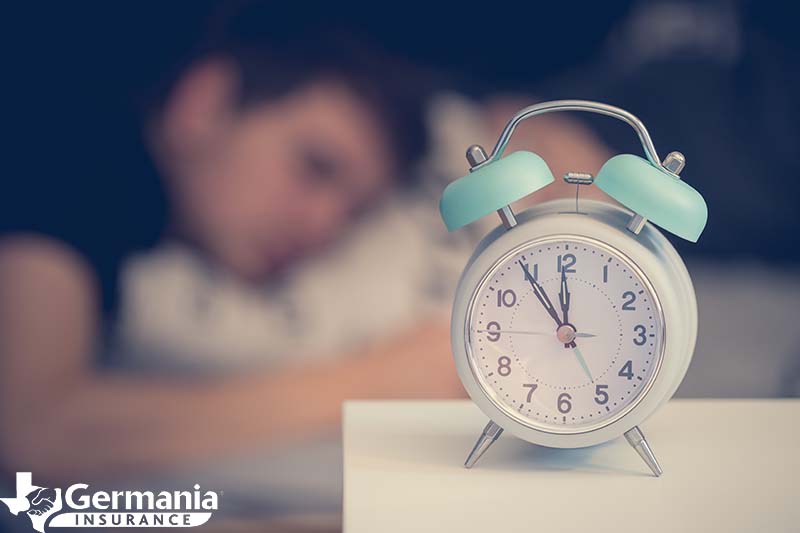Daylight saving time is ending! Find out how you can effectively adjust to the time change!

Each autumn, the changing season brings with it a lot of changes that most Texans are happy to welcome, like cooler weather and the start of the holidays. However, one change that may not be so easy to acclimate to is the end of daylight saving time.
When daylight saving time (DST) ends, we “fall back,” turning our clocks back one hour to go back to standard time. This year, DST ends on November 6, 2022 at 2 a.m.
While we have to deal with the changing time every year, adjusting to it never seems to get easier. That’s why we’ve put together some tips for helping you better acclimate to the end of daylight saving time this year.
Before we jump into the tips, let’s cover the basics…
When is daylight saving time?
In most of the United States, daylight saving time begins on the second Sunday in March and ends on the first Sunday in November. This year, daylight saving time started on Sunday, March 13, 2022 at 2:00 a.m. This is when we “spring forward” and set our clocks ahead one hour.
For many, the start of daylight saving time is difficult to adjust to because you’re essentially losing one hour, much like jet lag. However, when daylight saving time ends this year on Sunday, November 6, 2022, we set our clocks backward one hour at 2:00 a.m. — essentially giving us an extra hour.
On the surface, it may seem as though the end of daylight savings shouldn't be an issue because of that potential extra hour of sleep. However, falling back an hour also means that the sun rises and sets an hour earlier. Although we gradually get less sunlight as we approach winter, the stark change brought on by the end of daylight savings time can confuse our internal clocks known as our circadian rhythm.
When was daylight saving time created?
Daylight saving time was
first observed in 1916 in Germany. It was created in an effort to reduce the costs involved with wartime by allowing us to better synchronize our daytime activities with natural daylight hours.
In 1966, the United States adopted daylight saving time with the passage of the
Uniform Time Act of 1966. States were allowed to opt out of observing DST, but only Arizona and Hawaii opted out. In 2022, there are around 70 countries that currently observe daylight saving time.
How long does it take to adjust to daylight saving time?
There is no consensus on how long it takes to adjust to the time difference. Many sources suggest that adjusting to daylight saving time is similar to adjusting to jet lag. With jet lag, it often takes one day to adjust to one hour.
While this gives us a general understanding of how long it may take to adjust to DST, the truth is that it could take longer for some folks to adjust to the time change, leaving them with side effects like waking too early or sleeping too late.
How to adjust to the end of daylight saving time
The most significant way that the time changes involved with daylight saving time and the end of DST impact people is through their sleep. People with a standard 9-to-5 schedule may not see much difference when DST ends as they essentially just get an extra hour of sleep. However, people that work at night or parents with young children may need extra help adjusting.
Here are 5 tips for adjusting to the end of daylight saving time with minimal disruption to your sleep or your life in general:
1. Practice good sleep hygiene
The end of daylight saving time is a good opportunity to reset your sleep hygiene. Here are a few ways you can support better sleep habits:
- Have a bedtime. Go to sleep at generally the same time every night, and try to wake up at around the same time each day.
- Avoid screens before bed. Avoid looking at your phone or tablet an hour before bed, as it can make it harder to fall asleep.
- Create a comfortable sleep environment. Try only to use your bedroom for sleep, and create a comfortable environment conducive to sleep (quiet, dark, and cool).
- Set your thermostat lower at night. Lower temperatures help lull you to sleep as your body’s temperature decreases during sleep.
- Invest in a quality mattress. You spend so much of your time sleeping, it’s certainly worthwhile to invest in a quality mattress that you find comfortable and supportive.
2. Temporarily move your child’s bedtime
Toddlers often get up earlier than their parents want to, which is only exacerbated during the end of DST. For example, a child who typically goes to sleep at 8 p.m. and wakes up at 6 a.m. will now be on a 7 p.m. to 5 a.m. schedule. This can be painful for parents who aren’t early risers.
The solution? Temporarily move your child’s bedtime to
30 minutes later for three days before daylight saving time ends. Then, return to the old schedule after the time has changed. This will help the toddler or young child acclimate to the time change without forcing the parent to lose too much sleep.
3. Don’t forget about your pets
Your pets don’t know that it’s daylight saving time. If they are on a regular schedule, the time change may disrupt them as DST ends. This means that you may have to be more vigilant about feeding and bathroom trip times.
It may take your pet a couple of weeks to adjust to its new schedule. Just be patient and do what you can to ease any anxiety. Bribe them with treats and toys. And use a pet camera to monitor them for a while as they adjust.
4. Practice self-care
When daylight saving time ends, the sun rises an hour earlier and sets an hour earlier. This means that while you may have more time in the morning to enjoy the bright sun, you’ll have less time in the evening. This can cause a change in your mood that’s important to monitor and care for.
Take some extra time in November and December for self-care. Not only is this a busy time of the year with holidays, but the lack of light in the evening may cause your mood to dip. Spend extra time doing things that you enjoy and find relaxing like reading, pampering yourself, listening to music, leisure activities, or spending extra time with family and friends.
5. Use a light therapy device
Speaking of diminishing daylight, some people don’t adjust well to the lack of sunlight when daylight saving time ends. Those who are deeply affected by the change in light may experience depression or Seasonal Affective Disorder. For these folks, it will be important to get ahead of these issues before the time change.
A light therapy device allows those who are impacted by the lessening daylight to transition to darker days with fewer side effects. UV light therapy will not only help you boost your mood, but it can also improve sleep, energy, and focus.
While daylight saving time may not be adopted by the U.S. forever, for now, we have to deal with this time transition every year. If you have difficulty adjusting to the end of daylight saving time, these tips should help support you in the transition and lessen your chances of developing side effects like sleep issues.
 Germania Insurance is here to serve Texans in every season! To learn more about our products and services, request a free quote online or reach out to your local agent today!
Germania Insurance is here to serve Texans in every season! To learn more about our products and services, request a free quote online or reach out to your local agent today!